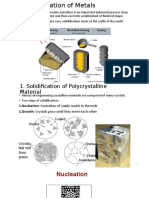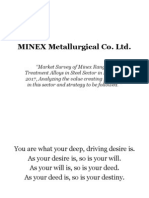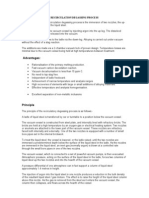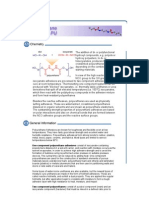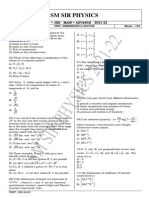0 ratings0% found this document useful (0 votes)
123 viewsGalvanizing Process
Galvanizing Process
Uploaded by
Reymart C. Entera TRUE
TRUE
TRUE
FALSE, cleaned, treated with flux at 700C and then again treated with another flux at 7300C.
TRUE
TRUE
FALSE, corrosion and erosion resistance
TRUE
FALSE, Sherardising is a process of galvanization of ferrous metal surfaces, also called vapour galvanising and dry galvanizing.
Copyright:
© All Rights Reserved
Available Formats
Download as PPTX, PDF, TXT or read online from Scribd
Galvanizing Process
Galvanizing Process
Uploaded by
Reymart C. Entera0 ratings0% found this document useful (0 votes)
123 views27 pages TRUE
TRUE
TRUE
FALSE, cleaned, treated with flux at 700C and then again treated with another flux at 7300C.
TRUE
TRUE
FALSE, corrosion and erosion resistance
TRUE
FALSE, Sherardising is a process of galvanization of ferrous metal surfaces, also called vapour galvanising and dry galvanizing.
Copyright
© © All Rights Reserved
Available Formats
PPTX, PDF, TXT or read online from Scribd
Share this document
Did you find this document useful?
Is this content inappropriate?
TRUE
TRUE
TRUE
FALSE, cleaned, treated with flux at 700C and then again treated with another flux at 7300C.
TRUE
TRUE
FALSE, corrosion and erosion resistance
TRUE
FALSE, Sherardising is a process of galvanization of ferrous metal surfaces, also called vapour galvanising and dry galvanizing.
Copyright:
© All Rights Reserved
Available Formats
Download as PPTX, PDF, TXT or read online from Scribd
Download as pptx, pdf, or txt
0 ratings0% found this document useful (0 votes)
123 views27 pagesGalvanizing Process
Galvanizing Process
Uploaded by
Reymart C. Entera TRUE
TRUE
TRUE
FALSE, cleaned, treated with flux at 700C and then again treated with another flux at 7300C.
TRUE
TRUE
FALSE, corrosion and erosion resistance
TRUE
FALSE, Sherardising is a process of galvanization of ferrous metal surfaces, also called vapour galvanising and dry galvanizing.
Copyright:
© All Rights Reserved
Available Formats
Download as PPTX, PDF, TXT or read online from Scribd
Download as pptx, pdf, or txt
You are on page 1of 27
Galvanizing process
Hot-dip galvanizing is the process of immersing iron or steel in a bath of
molten zinc to produce a corrosion resistant, multi-layered coating of
zinc-iron alloy and zinc metal. While the steel is immersed in the zinc,
a metallurgical reaction occurs between the iron in the steel and the
molten zinc. This reaction is a diffusion process, so the coating forms
perpendicular to all surfaces creating a uniform thickness throughout
the part.
The hot-dip galvanizing process (Figure 1) has been used since 1742,
providing long-lasting, maintenance-free corrosion protection at a
reasonable cost for decades. Although hot-dip galvanizing has been
utilized to protect steel for generations, the galvanizing process
continues to evolve with new technologies and creative chemistries. The
three main steps in the hot-dip galvanizing process are surface
preparation, galvanizing, and post-treatment, each of which will be
discussed in detail. The process is inherently simple, which is a distinct
advantage over other corrosion protection methods.
FIGURE 1
Galvanizing
Once the steel has been completely cleaned, it is ready for immersion
in the zinc bath. The galvanizing kettle contains zinc specified to
ASTM B6, a document that specifies any one of three grades of zinc
that are each at least 98% pure. Sometimes other metals may be added
to the kettle to promote certain desirable properties in the galvanized
coating.
The galvanizing kettle (Figure 5), is heated to a temperature ranging
from 820-860 F (438-460 C), at which point the zinc is in a liquid state.
The steel products are lowered into the galvanizing kettle at an angle,
and stay in the bath until the steel heats to the bath temperature.
Once the diffusion reaction of iron and zinc is complete, the steel
product is withdrawn from the zinc kettle. The entire dip usually lasts
less than ten minutes, depending upon the thickness of the steel.
The coating, as seen in Figure 6, is typical for low silicon steels with
silicon impurities less than 0.04% and where the thickness of the
coating is limited by the interdiffusion of iron and zinc
Figure 6
Figure 5
Post-Treatment
When the steel is removed from the galvanizing
kettle, it may receive a post-treatment to enhance
the galvanized coating. One of the most commonly
used treatments is quenching. The quench tank
contains mostly water but may also have chemicals
added to create a passivation layer that protects
the galvanized steel during storage and
transportation. Other finishing steps include
removal of zinc drips or spikes, by grinding them
off.
Filing Zinc Drips
Sherardizing
Sherardizing is a process of galvanization of ferrous
metal surfaces, also called vapour galvanising and dry
galvanizing. The process is named after the British
metallurgist Sherard Osborn Cowper-Coles (son of
naval inventor Cowper Phipps Coles) who invented
and patented the method ca. 1900.This process
involves heating the steel parts up to ca. 500°C in a
closed rotating drum that also contains metallic zinc
dust and possibly an inert filler, such as sand. At
temperatures above 300°C, zinc evaporates and
diffuses into the steel substrate forming diffusion
bonded Zn-Fe-phases.
Sherardising is ideal for small parts and
parts that require coating of inner surfaces,
such as batches of small items. Part size is
only limited by the drum size. It is reported
that pipes up to 6 m in length for the oil
industry are sherardised.[citation needed] If
the metal surface is free of scale or oxides,
no pretreatment is needed. The process is
hydrogen free, therefore a hydrogen
embrittlement is excluded.
Colorizing
Colorizing is a metallurgical process for treating the Process
quality is monitored by testing coupons ( of surface of steels,
stainless steels and alloys, with the same grade of metal) that
are run in the retort with aluminium that provides protection
against elevated- the production materials. The nature of the
process, temperature, scaling and corrosion. the air-tight
retorts and the controlled atmospheres ensure uniform alloy
protection over the entire surface Adding aluminium to
carbon and stainless steel is of the Calorising materials. After
the process is commonly known to improve corrosion
resistance. A completed, the coupons are removed from the
retort, side effect of the process, however, is unfavorable
sectioned and examined in a laboratory for quality and
changes in the mechanical properties of the base steels. depth
of diffusion.
During the Calorising process, the steel is chemically
carburization, scaling and hydrogen permeation. All
cleaned, treated with flux at 700C and then again types
of wrought and cast steels can be Calorised: treated
with another flux at 7300C. After this, the plain carbon
and low alloy grades, ferritic and steel dipped in
molten aluminum alloy at 7700C. austenitic steels,
high-temperature values of the process This results in
an evenly aluminium coated steel. Then determine the
specification of steel to be Calorised.
Technical Benefits • High corrosion resistance. • Case
depth up to .015" for tubing. • Operates in continues
temperatures up to 1750 degrees F. • Retains the base
steel's inherent strength and rigidity, depending on
base material. • Does not change the high-temperature
mechanical properties of the base steel. • Utilizes
Indra Udyog Technologies' patented diffusion alloying
process.
Common Applications • Sulfuric acid/ acid gas
removal : Resists sulfidation from H2S, SO3; increases
tube life up to 20 years. • Refining: Charge heaters,
delayed cokers, sulfur recovery, heat exchangers. •
Petrochemical: Reformers, ammonia, heat exchangers.
• Reformers – DRI: Secondary reformers, waste heat
boilers. • Boilers : PR boiler (pulp and paper),
waterwall panels, traditional boilers.
Alloys with greater nickel contents can withstand even
The replacement piece was Calorised and the pipe
higher working temperatures. There is a limit,
remained sound and unaffected by many subsequent
however, to the maximum amount of nickel that can
exposures to the same reagents at the same be used in
an alloy exposed to high-temperatures temperatures
sulfidation. With nickel contents of 25% or more, the
nickel will preferentially combine with sulfur to create
a low- melting temperature nickel sulfide eutectic.
Chromising
Chromising, or chromising, can protect components
from corrosion, wear, abrasion and oxidation.
Chromide diffusion coatings were originally developed
by Diffusion Alloys for hot section industrial gas
turbine blades and vanes to protect them against high
temperature oxidation and hot corrosion. Over the
years, chromised component applications have
widened considerably and we now coat for a wide
range of industries, including Oil & Gas, Process,
Steel, Textile and Renewables.
Steels with carbon content greater than 0.3% can form a hard dense
diffused chromium carbide surface layer which has high hardness
and excellent wear resistance. Typical materials that are suitable for
chromising / chromizing include:
Low carbon steels:
Oxidation resistance to 650℃; corrosion resistance similar to
ferritic stainless steel
Medium carbon steels:
Light wear and corrosion resistance
High carbon steel:
Wear resistance and corrosion resistance
Stainless steels:
Wear resistance and corrosion resistance
Nickel & Cobalt base super alloys:
Corrosion and erosion resistance
Questions:
Modified true or false
Write TRUE if it’s correct and if False write the correct to make
the statement correct.
1.) Metallurgy is ideal for small parts and parts that
require coating of inner surfaces, such as batches of
small items.
2.) Oxidation resistance to 610℃; corrosion resistance
similar to ferritic stainless steel.
3.) Chromising can protect components from corrosion,
wear, abrasion and oxidation.
4.) During the Calorising process, the steel is chemically
carburization, scaling and hydrogen permeation.
5.) When the steel is removed from the galvanizing kettle,
it may receive a pre-treatment to enhance the galvanized
coating.
6.) High carbon steel is a wear resistance and corrosion
resistance.
7.) Nickel & Cobalt base super alloys are corrosion and not
erosion resistance.
8.) Hot-dip galvanizing is the process of immersing iron or
steel in a bath of molten zinc to produce a corrosion
resistant, multi-layered coating of zinc-iron alloy and
zinc metal.
9 & 10.) Sherardising is a process of galvanization of ferrous
metal surfaces, also called air galvanising and carbon
galvanizing.
You might also like
- Stainless Steel RefiDocument19 pagesStainless Steel RefiDaiara Budi AlvesNo ratings yet
- Shift Reactor CalculationsDocument2 pagesShift Reactor Calculationsankitsamria0% (1)
- Carburizing, Nitriding, and Boronizing in Vacuum Furnaces - IpsenDocument9 pagesCarburizing, Nitriding, and Boronizing in Vacuum Furnaces - Ipsenarkan1976No ratings yet
- Externally Fired Microturbine FlyerDocument1 pageExternally Fired Microturbine FlyerPaulFerry100% (1)
- Chemistry Project On SpectrosDocument9 pagesChemistry Project On SpectrosAtul Sharma33% (3)
- Stainless Steel Metallurgy-Manufacturing Process, Grades & Role of Alloying ElementsDocument35 pagesStainless Steel Metallurgy-Manufacturing Process, Grades & Role of Alloying ElementsLalit MohanNo ratings yet
- ss304 NitridingDocument11 pagesss304 Nitridingvijayps.mechNo ratings yet
- Present Indian Steel Making Practice and Its Scenario: Introduction: WHAT IS STEEL?Document10 pagesPresent Indian Steel Making Practice and Its Scenario: Introduction: WHAT IS STEEL?SarbajitManna100% (1)
- Pneumatic Steelmarking - Chapter IV AOD ProcessingDocument6 pagesPneumatic Steelmarking - Chapter IV AOD Processinggau3koNo ratings yet
- Silver Casting.Document3 pagesSilver Casting.Richard.nlNo ratings yet
- Waste Heat Recovery System Operated in Midrex PlantsDocument2 pagesWaste Heat Recovery System Operated in Midrex PlantsMorteza RafieiNo ratings yet
- Boiler ManualDocument20 pagesBoiler Manualgflores65100% (2)
- Cupola Furnaces Case StudyDocument5 pagesCupola Furnaces Case StudyPutt LaLuNo ratings yet
- Steam Hydrocarbon Reforming, Hydrogen Reformer, Steam Methane Reformer - Products and Services - SELAS FLUID A Linde Engineering Division MemberDocument1 pageSteam Hydrocarbon Reforming, Hydrogen Reformer, Steam Methane Reformer - Products and Services - SELAS FLUID A Linde Engineering Division Membernizam17100% (1)
- Teory For Acetylene VCDocument6 pagesTeory For Acetylene VCRamesh JakkanagoudarNo ratings yet
- Revised DraftDocument45 pagesRevised DraftEva LloydNo ratings yet
- Magnets and Their Specifications: MEDER Electronic About MagnetsDocument6 pagesMagnets and Their Specifications: MEDER Electronic About MagnetsKant NautiyalNo ratings yet
- Alumina Brick RESCODocument2 pagesAlumina Brick RESCOgems_gce074325No ratings yet
- Low Press Carbg and High Press QNCHGDocument56 pagesLow Press Carbg and High Press QNCHGskluxNo ratings yet
- Workshop AssignmentDocument16 pagesWorkshop AssignmentMelvin Ariel BautistaNo ratings yet
- Some Ironfounding Cupola Furnace in Asia and EuropeDocument4 pagesSome Ironfounding Cupola Furnace in Asia and EuropeKhin Aung ShweNo ratings yet
- MCM AllDocument7 pagesMCM AllPalanisamy RajaNo ratings yet
- Texture Evolution in Grain-Oriented Electrical Steel During Hot Band Annealing and Cold RollingDocument10 pagesTexture Evolution in Grain-Oriented Electrical Steel During Hot Band Annealing and Cold Rollingد. علا محمد حداويNo ratings yet
- Electrolytic Nickel Phosphorus PlatingDocument34 pagesElectrolytic Nickel Phosphorus PlatingKhoa Vũ100% (1)
- Alternatives For Hot Metal Production - Cupola, Induction and Arc FurnaceDocument27 pagesAlternatives For Hot Metal Production - Cupola, Induction and Arc FurnaceJorge Madias100% (1)
- Principles of Metallurgical OperationsDocument38 pagesPrinciples of Metallurgical OperationsMuhammad Saim100% (1)
- Catalytic Converter: BY Seminar Guide Ambikesh Pandey MR - Rohit Singh U.ROLL - NO.-1612240036 (Assistant Prof.)Document16 pagesCatalytic Converter: BY Seminar Guide Ambikesh Pandey MR - Rohit Singh U.ROLL - NO.-1612240036 (Assistant Prof.)jatinshukla431No ratings yet
- Aisi 305Document3 pagesAisi 305Aditya PratapNo ratings yet
- Blast Furnace Iron MakingDocument9 pagesBlast Furnace Iron MakingVishwanath HunagundNo ratings yet
- Development of High Strength Construction RebarsDocument13 pagesDevelopment of High Strength Construction Rebarsosman recai100% (3)
- Lesson 1 Iron and Steel ManufacturingDocument28 pagesLesson 1 Iron and Steel ManufacturingMercie KishNo ratings yet
- CRISP+ Furnace Overview 2022.03.24Document5 pagesCRISP+ Furnace Overview 2022.03.24Leandro DijonNo ratings yet
- Determination of Inclusions in Liquid Steel After Calcium TreatmentDocument4 pagesDetermination of Inclusions in Liquid Steel After Calcium TreatmentWendel De Carvalho TôrresNo ratings yet
- Lopper Auto Feed Log BoilerDocument12 pagesLopper Auto Feed Log Boilerglynis100% (3)
- MetalsMagazine 2 2018 PDFDocument116 pagesMetalsMagazine 2 2018 PDFJack 123No ratings yet
- Fire Brick - Wikipedia, The Free EncyclopediaDocument2 pagesFire Brick - Wikipedia, The Free EncyclopediareaktorenergiNo ratings yet
- 08108057-Open Hearth ProcessDocument20 pages08108057-Open Hearth Processkchoudhary86No ratings yet
- Tempcore ProcessDocument23 pagesTempcore ProcessKumaran 1987No ratings yet
- Solidification of MetalsDocument13 pagesSolidification of MetalsDalitso Tembo100% (1)
- Stainless Steel Production by IfDocument4 pagesStainless Steel Production by IfAbhinav TiwariNo ratings yet
- Steel Industry Glossary of TermsDocument14 pagesSteel Industry Glossary of TermsSoumyo Broto DasNo ratings yet
- ALLOY 625 MaterialsDocument1 pageALLOY 625 Materialsvickyflyer1No ratings yet
- MINEX Metallurgical CoDocument41 pagesMINEX Metallurgical CoPriyank SamagraNo ratings yet
- Vacuum Metallurgy & Secondary SteelmakingDocument18 pagesVacuum Metallurgy & Secondary Steelmakingdroy21No ratings yet
- FerrousDocument538 pagesFerrousPutoy Itoy100% (1)
- 8 Investment Casting ProcessDocument2 pages8 Investment Casting ProcessFahri RamadhanNo ratings yet
- Current Refractory Technology and Practices in The Steel IndustryDocument25 pagesCurrent Refractory Technology and Practices in The Steel IndustrySebastian SolanoNo ratings yet
- Welding and Corrosion Performance of INCO-WELD 686CPT Filler Metal in Waste-To-Energy Power PlantsDocument6 pagesWelding and Corrosion Performance of INCO-WELD 686CPT Filler Metal in Waste-To-Energy Power PlantsErdem ÜnelNo ratings yet
- Duplex Stainless Steel 329 or 1.4460 PDFDocument2 pagesDuplex Stainless Steel 329 or 1.4460 PDFtien100% (1)
- Overview - RefractoriesDocument41 pagesOverview - RefractoriesRogerShNo ratings yet
- Stainless Steel 410Document2 pagesStainless Steel 410Suriyachai NiamsornNo ratings yet
- Slag ItroductionDocument45 pagesSlag ItroductionkidcatNo ratings yet
- Refractories FinalDocument19 pagesRefractories FinalKlarizza BraciaNo ratings yet
- Manufacturing of SteelDocument3 pagesManufacturing of Steelveenau 1No ratings yet
- Steel Casting Handbook Supplement 8 - High Alloy Data Sheets - Corrosion SeriesDocument93 pagesSteel Casting Handbook Supplement 8 - High Alloy Data Sheets - Corrosion SeriesjosemiguelzuNo ratings yet
- GALVASTEELDocument15 pagesGALVASTEELRodimar Eduagin100% (1)
- Material ScienceDocument20 pagesMaterial ScienceKushNo ratings yet
- Steel DictionaryDocument85 pagesSteel DictionaryveroniquearnaudNo ratings yet
- Hot-Dip Galvanization - WikipediaDocument4 pagesHot-Dip Galvanization - WikipediaaravindNo ratings yet
- Chemical Basis of Life: Why Study Chemistry in An Anatomy and Physiology ClassDocument129 pagesChemical Basis of Life: Why Study Chemistry in An Anatomy and Physiology ClassKalsoom KhalidNo ratings yet
- Privious Year Question 2019Document12 pagesPrivious Year Question 2019Haripratap SikarwarNo ratings yet
- Safety Data Sheet: 1. Product and Company IdentificationDocument4 pagesSafety Data Sheet: 1. Product and Company IdentificationGabriel Morales GutierrezNo ratings yet
- Water Technology 2015 2016 1Document86 pagesWater Technology 2015 2016 1Srinivas AkHilNo ratings yet
- Asymmetric OrganocatalysisDocument467 pagesAsymmetric Organocatalysisnombre panchoNo ratings yet
- Steinecker Boreas: Wort Stripping of The New GenerationDocument16 pagesSteinecker Boreas: Wort Stripping of The New GenerationAlejandro Javier Delgado AraujoNo ratings yet
- Testing BiodegradabilityDocument2 pagesTesting BiodegradabilityAloisio CottaNo ratings yet
- Stoichiometry Moles PDFDocument33 pagesStoichiometry Moles PDFAhmadNo ratings yet
- Biomass-Fed Furnace PDFDocument1 pageBiomass-Fed Furnace PDFluzviminda ramosNo ratings yet
- Learning Activity Sheet (Las) No. 1Document4 pagesLearning Activity Sheet (Las) No. 1warren bascon100% (1)
- Differential Pulse Voltammetric Determination of Paracetamol at Nanogold Modified Indium Tin Oxide ElectrodeDocument5 pagesDifferential Pulse Voltammetric Determination of Paracetamol at Nanogold Modified Indium Tin Oxide ElectrodeYoselin GomezNo ratings yet
- The Sugar IndustryDocument22 pagesThe Sugar IndustryAbraham wisdomNo ratings yet
- Design For ShaftDocument60 pagesDesign For ShaftMarlNo ratings yet
- ASP Cryogenics For Particle AcceleratorsDocument64 pagesASP Cryogenics For Particle AcceleratorsASHITA K BNo ratings yet
- A Level Chemistry Exemplars With CommentariesDocument103 pagesA Level Chemistry Exemplars With CommentariesWeb Books0% (1)
- Inertial Reference Frames: Example 1Document2 pagesInertial Reference Frames: Example 1abhishek murarkaNo ratings yet
- Lecture 3Document12 pagesLecture 3Assma MohamedNo ratings yet
- Air Receivers Volume CalculationDocument83 pagesAir Receivers Volume CalculationsudarwantoNo ratings yet
- Calculation Headline: Roof GeometryDocument2 pagesCalculation Headline: Roof GeometryvtalexNo ratings yet
- One-Component Polyurethane Adhesives Consist of Isocyanate-ContainingDocument3 pagesOne-Component Polyurethane Adhesives Consist of Isocyanate-ContainingLuis Alberto GutiérrezNo ratings yet
- Factory Address: Luohuang Industrial Park, Jiangjin Dist., Chongqing, China E-Mail: TelDocument23 pagesFactory Address: Luohuang Industrial Park, Jiangjin Dist., Chongqing, China E-Mail: Telmarouane benbelaidNo ratings yet
- Pallab GoshDocument519 pagesPallab GoshbhoomikavinaycheguNo ratings yet
- Ch11 AllProblem KeyDocument55 pagesCh11 AllProblem KeyHarnani Sharuddin100% (3)
- Fiflows Thai Version PDFDocument3 pagesFiflows Thai Version PDFSaowalak PhonseeNo ratings yet
- NaAu and CsAu Bimetal ClustersDocument12 pagesNaAu and CsAu Bimetal Clustersjt_scribdNo ratings yet
- Science-10 - Q4 - Mod1.2 Charles LAWDocument6 pagesScience-10 - Q4 - Mod1.2 Charles LAWchiekoNo ratings yet
- TEST (Units, Dimensions&Vector)Document3 pagesTEST (Units, Dimensions&Vector)subhajitbose634No ratings yet
- ADA290876Document74 pagesADA290876mlutfimaNo ratings yet






































